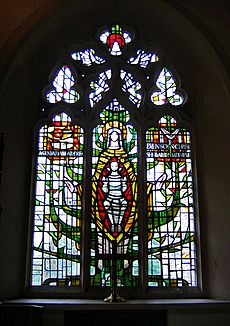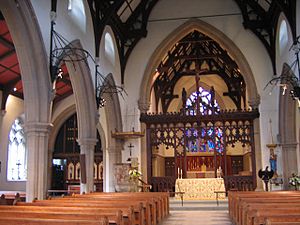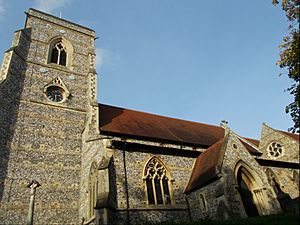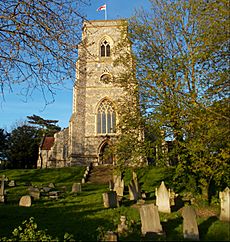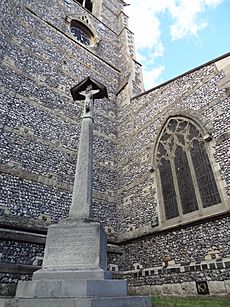All Saints Church, Benhilton facts for kids
Quick facts for kids All Saints Church, Benhilton |
|
|---|---|
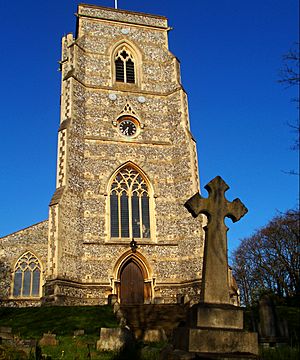 |
|
| Lua error in Module:Location_map at line 420: attempt to index field 'wikibase' (a nil value). | |
| Country | England |
| Denomination | Church of England |
| Churchmanship | Anglo-Catholic |
| Architecture | |
| Designated | 15 September 1863 |
| Architect(s) | Samuel Teulon |
| Completed | 1906 |
| Administration | |
| Diocese | Diocese of Southwark |
All Saints Church, Benhilton, is a special church in Sutton, Greater London, England. It belongs to the Church of England. This beautiful church was built a long time ago, between 1863 and 1867. It's considered a very important building. Historic England calls it a great example of Victorian church design. It was designed by a famous architect named Samuel Sanders Teulon.
Contents
Where is All Saints Church?
The church is located just north of the Sutton town centre. You can find it east of Angel Hill on All Saints Road. It looks down towards Sutton Green. The church stands on a raised area, like a platform. This platform was partly made from earth moved during road building in the 1770s. Because it's so big and easy to see, it's a well-known landmark in the area.
History of the Church
How the Church Began
The area around the church, called Benhilton, became its own church district on September 15, 1863. The first stone of the church was laid in the same year. It was designed by Samuel Sanders Teulon in the Gothic Revival style. This style was popular for churches back then.
A very important person in the church's history was Thomas Alcock. He owned a lot of land in the area. He gave £18,000 to build the church, the vicarage (the priest's house), and a school. He also gave the land for these buildings. Mr. Alcock wanted to build fancy Victorian houses nearby. The church was meant to be a nice place for the people living in these new homes.
Building the Church Over Time
The main part of the church, called the nave, and the south side aisle were built first. The tall tower and the chancel (the area around the altar) were added in 1867. The north side aisle wasn't fully finished until 1906.
The church has always been famous for its bells. The first bell, a large one called the tenor bell, was given by Thomas Alcock. It was rung when the church was officially opened. A special frame for eight bells was put in the tower in 1877. More bells were added over the next few years. By 1882, there were six bells. All eight bells were first rung together on November 1, 1893, which is All Saints Day.
Church Details from 1903
Kelly's Directory of Surrey 1903 is like an old phone book and guide. It said that the Benhilton church district was created in 1863. The church was built in 1865. The total cost, including the land, house, schools, and money for the church, was £24,000.
The church was made of flint stone in an old style called Early Decorated. It had a tower with a clock and 8 bells. The beautiful stained glass window at the east end was a memorial to Thomas Alcock. The church had 874 seats, and half of them were free for anyone to use. Records for the church started in 1866. In 1901, the area had a population of 3,503 people.
Cool Architectural Features
The church has a wide main area called a nave. It has round windows high up, called clerestory windows. There's also a chancel, north and south aisles, and a special area called the Lady Chapel. It has rooms for priests (vestries) and an organ room above them. There's a big tower at the west end and two porches.
The church is built with bricks, but the outside is covered with flint stone. It has natural stone decorations and a wooden roof covered with clay tiles. Historic England says the church is a great example of mid-Victorian church building. It looks almost exactly as it did when it was first built. It has interesting features, including stained glass windows from the 1960s and a striking roof.
The Tower and Windows
The church has a large tower with four levels at its western end. The tower has a doorway and a big window with four sections. Like other main windows, it has fancy stone patterns called tracery. There are three clocks on the tower, one on the north, south, and west sides. They are under small gables with more tracery. The bell tower section has two-part windows on each side. The tower also has strong supports called buttresses and a staircase that goes higher than the rest of the tower.
Above the side aisles, there's a narrow band of circular windows. These windows have cool patterns inside, like triskele (three spirals) or mouchette and quatrefoil (leaf-like shapes). The windows in the aisles are wide and have three sections with flowing tracery. The windows in the Lady Chapel show Mary with baby Jesus. These were designed in 2001 by John Lawson.
Other Unique Details
Both the southern chapel and northern vestry have their own gabled roofs. They have detailed three-part windows, similar to those in the aisles. The entrances to both porches are decorated. The northern porch has a vaulted ceiling.
An unusual thing about the outside walls is that you can still see traces of old holes. These holes were used for scaffolding when the church was being built. You often see these on very old medieval buildings. But usually, builders in Victorian times would carefully fill them in. Here, they were left visible, almost like a design feature.
Church Grounds and Memorials
Around the church, there is an old churchyard. It has several important tombs. The churchyard is wooded, with yew trees growing near the path to the north porch.
At the southwest corner of the church, there is a memorial. It remembers the men from the church and area who died during the First World War. The words on it say: "In memory of those who from this parish and congregation laid down their lives for their King and country, 1914-1918. For all live unto Him. Luke XX." There is also a smaller memorial next to it for F.A. Munford. In total, 54 men from the area lost their lives in that war.
The Church Bells
The All Saints Benhilton Society of Change Ringers was started in 1896. Since then, they have regularly practiced and rung the bells for services. They only stopped for a short time during the Second World War. The bell tower was repaired by the ringers in 1970. A new set of eight bells was blessed in 1971. These bells were made by the Whitechapel Bell Foundry. The largest bell, the tenor bell, weighs about 13.5 hundredweight (around 685 kg) and is tuned to F#.
Bell practice happens on Tuesdays from 7:45 pm to 9:15 pm. The bells are also rung on Sundays from 8:45 am to 9:30 am. The person in charge of the bell ringers is Jeremy Cheesman.


